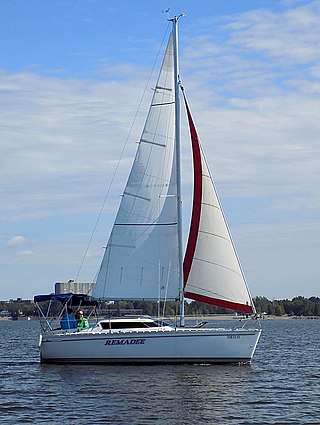Related Research Articles

The Tonic 23 is a French trailerable sailboat, that was designed by Philippe Harlé as a coastal cruiser and first built in 1985.
The Bristol Caravel 22, sometimes called the Bristol 22 Caravel, Sailstar Caravel, or just the Caravel 22, is an American trailerable sailboat that was designed by Halsey Chase Herreshoff as a cruiser and first built in 1968. It is named for the class of sailing ship.
The Captiva 240 is an American trailerable sailboat that was first built in 1984. The boat is a development of the O.H. Rodgers-designed Rodgers 24 racer, modified for use as a racer-cruiser by Walter Scott by giving it a new keel and sailing rig.
The Coronado 25 is an American trailerable sailboat that was designed by Ed Edgar and Frank W. Butler as a cruiser and first built in 1966.
The Irwin 25 is an American trailerable sailboat that was designed by Ted Irwin as a cruiser and first built in 1969.
The Bahia 22, also called the Bahia 23, is a French trailerable sailboat that was designed by Philippe Harlé as a pocket cruiser and first built in 1983.
The Merit 22 is an American trailerable sailboat that was designed by Paul Yates as a racer-cruiser and first built in 1981.
The Morgan 22 is an American trailerable sailboat that was designed by Charley Morgan as a racer-cruiser and first built in 1968.
The Neptune 24 is an American trailerable sailboat that was designed as a cruiser and first built in 1978.
The New Horizons 26 is an American trailerable sailboat that was designed by Sparkman & Stephens as a cruiser and first built in 1958. It was Sparkman & Stephens design #1235.
The O'Day 19 is an American trailerable sailboat that was designed by John Deknatel of C. Raymond Hunt Associates, as a racer-cruiser and first built in 1979.
The Mustang 22 is an American trailerable sailboat that was designed by Martin Bludworth as a Midget Ocean Racing Club racer and first built in 1969.
The S2 6.8 is an American trailerable sailboat that was designed by Don Wennersten and Arthur Edmunds as a racer-cruiser and first built in 1976. The designation indicates the approximate length overall in meters.
The S2 7.0 is an American trailerable sailboat that was designed by Arthur Edmunds as a cruiser and first built in 1975. The designation indicates the approximate length overall in meters.
The Sailmaster 22 is a Dutch and American trailerable sailboat that was designed by Sparkman & Stephens as a cruiser and daysailer and first built in 1963. It was Sparkman & Stephens design #1743.
The Santana 25 is an American trailerable sailboat that was designed by W. Shad Turner as an International Offshore Rule Quarter Ton class racer and first built in 1973. The boat was Turner's first design.
The Seafarer 23 Kestrel is a Dutch trailerable sailboat that was designed by Sparkman & Stephens in daysailer and cruiser models, first built in 1963.
The Yankee 26 is an American trailerable sailboat that was designed by Sparkman & Stephens as an International Offshore Rule Quarter Ton class racer-cruiser and first built in 1974. The boat is Sparkman & Stephens design #2065.1.
The SHE 36 is a British sailboat that was designed by Sparkman & Stephens as an International Offshore Rule Three-Quarter Ton class racer-cruiser and first built in 1977.
The Tartan 27 is an American trailerable sailboat that was designed by Sparkman & Stephens as a cruiser-racer and first built in 1961. It is Sparkman & Stephens' design #1617.
References
- 1 2 3 4 5 6 7 McArthur, Bruce (2020). "D&M 22 sailboat". sailboatdata.com. Archived from the original on 10 March 2021. Retrieved 10 March 2021.
- ↑ McArthur, Bruce (2021). "Sparkman & Stephens". sailboatdata.com. Archived from the original on 10 August 2020. Retrieved 10 March 2021.
- 1 2 3 4 5 6 7 8 9 Henkel, Steve: The Sailor's Book of Small Cruising Sailboats, page 166. International Marine/McGraw-Hill, 2010. ISBN 978-0-07-163652-0
- ↑ McArthur, Bruce (2021). "Douglass & McLeod 1951 - 1971". sailboatdata.com. Archived from the original on 2 October 2020. Retrieved 10 March 2021.
- ↑ "Designs and New Boats - Three compromises and one all-out racer". Motor Boating & Sailing. February 1972. Retrieved 10 March 2021.